rhizomes.07 fall 2003
A Short History of the Future of Walking
Phil Smith
hihi Beshihihihi Beshihi hihi Beshihi Bess - this wilhihi Beshihi hihi Beshihi Bess - this will be myhihi Beshihi hihi Beshihi Bess - this will be my last email of this juneyhihi Bess - this will be my last email of this juney so thank you for takhihi Bess - this will be my last email of this juney so thank you for takin part in isolidaity or the competition with neighbours i do not now - just ben to southern art of box 10 - sugar icing churc, inside thet think i a a thif an ask,me oenquestins like are you local? thy have turned heir cros into a snowflake. outside there is ahuge crumbling daethly wall it,s been falling doen fot cere are twolarge wedges okdingit all u - the icing sugar church and h thik deahtly wall - my lest site on his derive, thank you, bess phil
(email to Bess Lovejoy from Phil Smith, 19.12.01)
[1] I have been on a journey. It starts among exhibits of fishing nets, lobster pots and fish tanks on the lower floor of a former fish warehouse, once a maritime museum, where four years ago I tried to create an autobiographical performance through the prism of seaside holidays. But was kicked upstairs into an empty room by the city council.
[2] The point on the journey I have now reached is somewhere between cathedral-Moto-cathedral - a moderated "drift" or "dérive", walked on the 3rd March, 2002 , to find rural routes from the edge to the heart of the city of Exeter, England and the series of walks subsequently inspired by it.
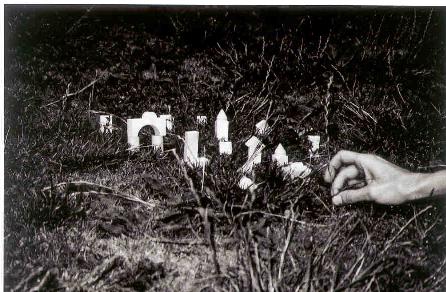
[3] I have not chosen a book for my autobiography, but walking and sites. Nor text, particularly, but sometimes. And spaces, specifically: our tiny back garden, my attic workplace, the discomforted place between two rooms of a gallery - one being the exhibition room forbidden to me. The ghost of that room, one storey up, I had haunted. But not alone. Once, I was isolated. My autobiography became too easily read as eccentricity. I didn't like that. Much more 'personal' to float free the associations of other performers or spectators with my own, in a neo-Symbolist orbiting of unlikes, a solar system in an oubliette. In which to meet one's own golem. In the room with no door. But windows looking out onto the town. Shout down to the passers-by. What do they see? Not one, but many. All the windows open simultaneously. The sky like those stars that float round a concussed head in a kids' cartoon. I am not writing stories, but exploring storeys I can use the architectural tales of Gustav Meyrink and Paul Leppin and the 5 minute hallways and sinking stairwells of Mark Z. Danielewski's House of Leaves as maps. Because in their monodramas the psychology is the place's, the character(istic)s those of city or ghetto or house.
«http://songlyrics.co.nz/albums/poe_haunted.htm»
[4] Because I want to make the invisible orbits of ideas and images visible. Because there is nothing innocent or sacred about these autobiographical spaces. Like NASA/ESA Hubble Space Telescope images of deep space, they can only become "innocent," can only reveal their complex manoeuvres, through "enhancement." They don't really "look" like that. They don't really "look" at all because no human eyes could perceive their relations. That's what self is in autobiography. Only visible when enhanced. Only "lookable" when compromised with the free-floating associations of colour, of grain, that could just as well be anyone's, be mine.
« http://sites.stsci.edu/pubinfo/pr/2002/11/»
[5] On the Moto Misguide (7th July 2002) we led guests to the Bishop's Court Quarry; the sandstone there formed as 'aeolian dunes,' dunes made by the action of the wind; the distribution of cross-bedding azimuths in the stone indicates a prevailing wind from the south-east to north-west. This quarry is a museum of breeze.
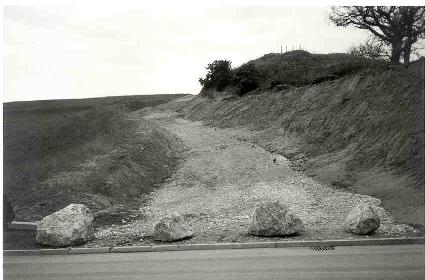
[6] Arriving back at the Cathedral Close, buildings all around are made of sandstone from Bishop's Court Quarry, some pockmarked with chunks of Exeter Volcanic Rock; lavas with "mean directions of magnetisation of 190° (declination) and - 10° (upwards inclination), consistent with their formation in a near equatorial position." [1]
[7] Eruptive movement is made solid. The
temperate 'earth' beneath our feet is on a long march from the equator.
Doreen Massey, Professor of Geography, Social Sciences at the Open University,
has called Skiddaw peak in the north of
[8] All places are "migrant." And our selves, similarly; not simple, single points of consciousness slipping across neutral planes, but selves that are motion and in motion within and without, extended 'organisms' shaped and shaping relations with each other, reacting to and adapting the geometry of inanimate geographies, cultural transmissions and ideology's reproductive system, moving about basins of attraction, patterned and patterning; a self as likely as any place to be "just passing through."
A dérive beginning just after 4am with a taxi-assisted catapult, us four blindfold and listening to personal cd players the driver paid £16 and asked to take us either South West, West, North or North East to the extent of the fare. He drops us off, describing the place as "featureless," handing over the receipt: "I lied about the destination on there so you can't cheat."
1/ the pylons
Those giants whose fall in the Tom Holland film signals the approach of the Langoliers, eating up the discarded past. The fierce buzz/hum. Pity the person who tries to live in the past, and the flying teeth come. [3]
[9] Choosing to make a biography of self in sites and movement feels like agency. Not a single Saul to Paul road moment, but more like a pattern. I meet, like another stranger, the image of a ruling self stored behind the eyes; organising the decision-making, inimitably recording unique recollections of itself. But, coming from 'my' direction I can't/won't recognise it as it would like me to. This 'walking' I'm doing is like mapping meme complexes clusters of competitive units of cultural currency of which the idea of a ruling, seated self is one of the survivors of a process of un-refereed natural selection among ideas and images, all nudging at my elbow as I write or walk. And among these complexes is the study of memes itself memetics a relative newcomer, first suggested by Richard Dawkins in The Selfish Gene (1976), a theory of cultural motion that does not recognise that regal stranger on the road.
[10] According to memetics, meme-complexes survive by the mimetic attractiveness of their vehicles, not on their own merits. And the same must apply to memetics if it is not to join the glamorous scrap heap of theories that can be applied to anything but themselves. For me that vehicle is the autobiographical 'Susan Blackmore,' populariser of memetics through her book The Meme Machine (1999): her struggle to find a testable ESP, eventual surrender to her own research results, return to a tainted, haunted world where, like a feminist detective novel heroine, she applied classical physics to mystery before moving on to memetics' diffusion of selfhood and challenge to the self's claim to have ghost-written itself. [4]
Does anyone ever follow the tracks of the pylons? Even their maintainers? From the countryside into the city isn't that where they're going? No good calling them ugly and forgetting them. Or calling them beautiful and patronising them. Because the city doesn't work without them. They are an urban path out here. They are an arterial route. No good walking the city and not walking them. And what strange structure is that in the middle distance, where we do not go? It would be such a difficult journey. The route of pylons cuts against the walkable. And the buzz/hum; how long could you stand it? The prospect of a journey of discomfort. Too close to dangerous power, an individual or small group walking in the energy field for tens of thousands.
I feel obliged to make that walk one day, but I don't relish it: to be a living cross-cutter, a cross-sectioner, an economic particle, a physics, to ride the line of illuminating, incinerating power, the power of the city. Dare? Ride the bodies electric? Hmm. [5]
[11] But the virtues of memetics [6], including its disruption of the single point of self with the vector of 'mimetic drive' useful to a walker negotiating the competing ideas and images in motion 'about' a route have been overshadowed by its pretensions to become a catch-all science of culture. Alongside holistic objections to memetics' breaking culture into "bits" and its resistance to experimental testing, a deep pall has been cast by Blackmore's radical enthusiasm, perhaps partly inspired by her Buddhism [7], for trashing agency along with the seated, sited self: "there is no room for guiding principles or inner selves with free will." [8] Agency has been elbowed out by her eponymous metaphor:
"Now we have a radically new idea of who we are. Each of us is a massive memeplex running on the physical machinery of a human body... - a meme machine...." [9]
This mechanical metaphor begs the question J. A. Scott Kelso asks of those who describe the brain as a computer: "Where is the programmer?" Kelso proposes a geometrical counter-metaphor to the machine: "a self-organized, functional unit, a metastable, dynamical form that relies on the system's openness for its creation, integrity and maintenance" [10], operating regardless of scale, from which he constructs "basic pattern forming principles" [11] as applicable to agency as anything else.
[12] Kelso's pattern-making and geometrical modelling is as rich a language to read the world in as memetics' vectors and natural selection. Against an unwieldy "one cause one effect" empiricism, here are pattern forming principles applicable by dérivistes to the 'migrant' world, strategies for creating 'situations' (experiments in living): intuitive interferences with control parameters ("the ratios of driving forces to dissipative forces" [12]) at times "when macroscopic patterns of behavior change qualitatively (and) the dynamics of the entire system may be dominated by one or a few order parameters... (and) an enormous compression of information." [13]
[13] One such compression is the optic flowfield, one of the "ways nature has devised to compress billions of (potential) degrees of freedom into a few functionally macroscopic qualities." [14] The dériviste sees the light from the layout of the surfaces s/he negotiates not as a representation of the endless details of the place s/he passes through but in the low-dimensional terms of their function (can they be climbed?) and in relation to the walker's own motion. The walker's pattern of agency is active in a flow of patterns, enabled by an awareness of compression ("not strictly... an achievement of the animal's nervous system, but rather... a process of an animal-environment system" [15]) and the basic pattern forming principles, to read and write in a language of 'simple' forms: "as immersed in the optic flowfield as a rock in a river. Just as vortices, eddies and ripples, and splashes arise and vanish in the total process of fluid motion, so too does the optic flowfield reveal meaningful events brinks, passages, openings, collusions as we intentionally move about in it." [16]

2/ the burnt and fragmented house
The old fire, wormhole back to lukewarm milk, larder and no fridge, Gran and Grandad Smith's house, mince pies - no mince and all pie - but the sash weight is alien, traces of another, upper class or somewhere older than a between the wars council bungalow, the melted plastic, melted glass (?), danger of cutting, infecting, "is that asbestos?" (Simon), stumbling on the jumbled bricks, ankles' fragility, danger of falling in between things and meanings, dusts, the frames, taunting with the demand to be re-made/kept the same. Mary, Amy, Simon and myself all start to reconstruct without a plan, working just in the details, assembling pieces of wood frame like black flames, building up the broken, scarred bricks into structures, pulling the fireplace into the middle of the larger frames, restoring the 'fire', ironical in all these ashes, dated from a "free offer" that ran out in 1992, a tabloid article about a medical students orgy: "syrup licked from girl's breast", "three lads in cucumber ordeal", wormhole back through the prose to what would they recognise of themselves in that now, arranged it before the fire, reading the newspaper in front of the fire, Pop, home from home, melted speakers, the redundant farm machine a benevolent/corrupt sentry, halved implements, a ferry tag for luggage, other places as holiday-sealed, I never for one moment considered the possibility that anyone might come and see us at what? 5.30 or 6am? [17]
Kelso's work is the basis for a theory of radical agency; modifying the flow of images and ideas through a model of anticipation that "stays in contact with the future by living near critical points," [18] modifying by enhancing critical fluctuations in control parameters that "may be said to anticipate an upcoming pattern change." [19] It is a geometry of the flow of relations rather than of components, that: "captures the co-operative behaviour between the parts, regardless of the parts themselves..." [20] Here then is memetics' mimesis, as the motor of cultural transmission, returning, but "regardless of the parts themselves", as a mimesis of relations, of dynamic patterns, rather than "bits," the frisson of a melding of vector and 'simple' shape.
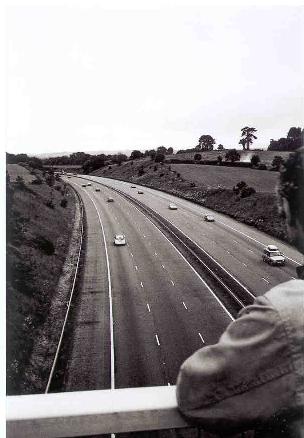
[14] What the walkers performing their autobiography through space see coming the other way person and environment is not an alien point of other, but another pattern, the critical edge of which they are seeking out. Thus the dériviste's autobiography is expressed not in representation, but in the engagement of one pattern making with another, not in "original" but in disruption.
We'd come upon the burnt treasure pile just as Simon was re-remembering the tyranny of the green sward... this sudden democracy, atomised, the fruit of re-formed plastics, popular, irreverent newspapers, uninvaded England where the owners choose to burn part of their home, lifted from its site and brought here to a burning non-site, half-burnt half-site, half-life, nuclear family? Or lonely individual? Left it half here, in this cubicle of grass, hedged in/off from the pasture. We had only begun to do what we could do... there was so much more to be built, to be a reconstruction, so many grains, so much soot, the atoms of a home selected, sifted, labelled and documented by fire. All the elements. Ready for reconstructing a dream house. We just built the door, a portico, a portal. And left without passing through it.
I'd like to return to this site with others, perhaps take things from our homes and continue to build/re-build this ghost place of home until it was possible to visit it, to pass through it. [21]

I still remember certain comic strips I read as a 10 year old: The Man With X Ray Eyes weeping at the suffering he saw behind the plane of a brick wall. Since then, I see through buildings. I can't take architectural appearance at face value. I favour a mild paranoia of "over-sensitivity". There was another strip where a tiny tennis ball-like object swooped down from the sky and some kids discovered it was a whole planet, with continents levelled and miniature populations fleeing about its surface. Then it floats up and away. And as I write this I still feel like it was my friends and me on a lawn in Delaware Road found that thing late one orange-skyed evening. Since then I see planets in tennis balls. Comic strips gave me geometry. As I walk I re-read surfaces. A simple plaque on the wall of a suburban Exeter garage - "Richard Ford (1796-1858) lived nearby" intellectually unscrewed by fellow dériviste Simon Persighetti is the mask of an absence: Ford's house, demolished in the 1960s, the only dwelling in the South West of England influenced by Islamic art.
[15] The meeting and passing of the shapes of place and self is the meeting and passing of two migrations.
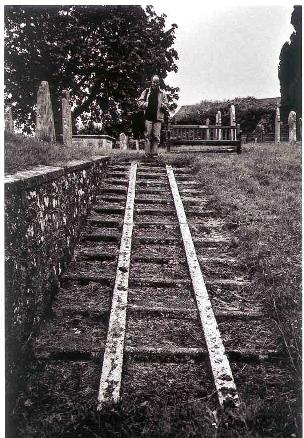
But there is no necessary equilibrium in their meeting. Nor in those meetings' encodings on the places themselves. Nor, in the conceptualising of the meetings by the selves that were there, is there a neutrality in their geometry. Instead there are the ambiguous patternings of the 'modern' (30 -50,000 year old) human mind and the gravitational pulls of ideology: a physics metaphor (returning gravity from General Relativity's curvature of space to its expression as a force) to complement the architecture of Althusser's "levels"; on its own too historically specific to the storeys of a bureaucratic state capitalist political building with printing press in the base(ment), offices and committee rooms in the superstructure above. 'Levels' that are constantly being collapsed back and forward into one another like the running backwards and forwards of film of building-demolitions (but there is no equilibrium in their collapsings).
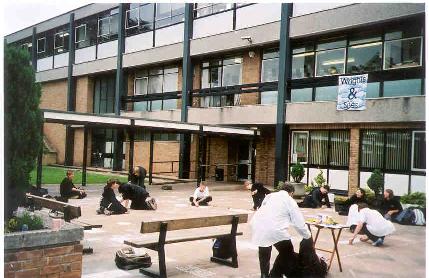
[16] In making a dynamic pattern for ideology for the apparent neutrality of a geometrical model of the world is only provisionally helpful to a dériviste - state capitalist architecture serves as a useful working metaphor for that hindsight of the "in the last instance" of a permeable self's distant determination by the social relations of production, but is inadequate for the complex and ambiguous interactions that then (have already) ensue(d). And there is a second problem attached to this architecture: the association of all mental production with it. This overstretching is an unconscious acknowledgement of the need for a further range of metaphor: of reproduction. A need for a theory of the competition, circulation and diffusion of ideas and images that would more appropriately fulfil Althusser's "ahistorical" claims for ideology more vector (memetic drive) than architectural plane.
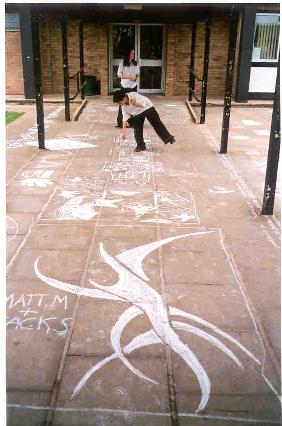
[17] A sorely challenged memetics is still a useful corrective to the 'neutrality' of both patterning and Althusser's levels, but to make it an overarching theory of everything would be to make it nothing. Its origins and articulation, as a theory of natural selection of ideas that pre-dates class societies, are just as subject to the ideological pulls of a society of unequal social relations as the architecture of Althusser's levels, its vocabulary distorted into the appearance of "naturalness" by the reproductive patterns of the existing social relations of production. Its value is in its dynamic relations with other 'failures,' theoretical and practical. Its "distortion" is no transgression of a natural order of transparent thinking, but a particular class/ideological expression of the historical ambiguities of the human mind; its discrete "chapels" of specialisation (memory of animal behaviour, of human sexual signals, etc.) collapsing somewhere between 50, 000 and 30, 000 years ago into one, according to the archaeologist Steven Mithen, "cathedral" structure of mind (the architectural reference is now mediaeval!) with a new confusion/ability to make metaphor.
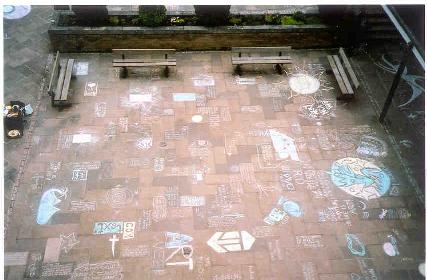
[18] The reclamation of memetics is a project of 'reverse archaeology' - a construction from ruins - excavating from its determinisn and meme-mind/machine-body dualism a means to measure the traces of complex trajectories in the patterns of both agencies and everything (else). The walker becomes an intentional dynamic pattern enmeshing with the dynamic pattern of everything (else), sensitised to the ideas and images in motion 'about' their path and 'about' themselves.
[19] All this theoretical manoeuvring is to create a space for... what? An aligning of the patterns of memories and associations with those of site like a Glass pattern in which random paint flecks are splashed onto paper, a transparency of the random flecks made and placed over the original and then rotated so that coherent patterns appear; typically circular, saddle-like, node, spiral or vortex the motion of walking facilitating the patterning necessary for an active autobiographical modifying of the orbits of memes 'about' a place.
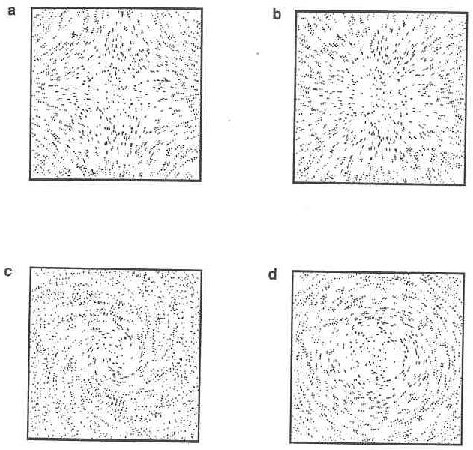
Four basic archetypal Glass patterns: (a) saddle, (b) node, (c) spiral,
and (d) vortex.
They may be generated by evolving a simple set of equations.
This means a seeking out of particular kinds of patterns in landscapes ambient hubs and places of dread (search for "Dread, Route & Time" at «www.reconstruction.ws») - conducive to the making of emergent actions and the assembling of artefacts that crunch together free-floating associations with the abstraction of maps. (Copies of artefacts Re:Bus (2002) and Taxi To Westwood and Featureless (2002) available from «perform.smith@ukgateway.net») These are not innocent landscapes. Unlike the ramblers' accepting contemplation of their surroundings, the dériviste digs at them in a parody of archaeology ("reverse archaeology"), trespassing across their demarcations, dramatising them to set their memes in motion, to provoke their patterns into making themselves visible in lower dimensions. There is a heightened shifting across borders of property, style, prohibition and performance, hunting after traces of "the co-operative behaviour between the parts, regardless of the parts themselves..." [22] accompanied by a theoretical presence in which architectural, physical, geometrical and natural science vocabularies are in competitive orbit about each other.
[20] Unlike Althusser's optimism for the privileged, fenced discourses of "scientific knowledge" and "authentic art" it is by the 'détourning' of such discourses (and those above), in juxtaposing them with unrespectable pseudo-ologies, in a neo-Symbolist floating free of their metaphors and their collision with the junk of translucent and geometrical ghosts, guidebooks, anomalous animals and crime stories that layer urban places, that this dériviste seeks to disrupt the material routine of working, shopping and pre-digested entertainment and the ideological routine of heritage, 'views' and no-go areas.
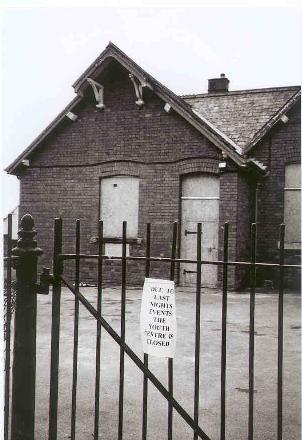
[21] This is not a slipping away from ideology, an escape to an innocent walking, or to a transparent, open-faced performance of place. (Innocence and transparency are only ever provisional tactics in an interventionist practice of site-specificity.) For the performance Forest Vague Panic (2001) in which I dramatised a domesticated autobiography of my fear of conspiracy theory and 'alternative history' our home, my intimate attic workplace in particular, was enhanced with the help of Punchdrunk's Felix Barrett.
« http://www.ex.ac.uk/~shodge/ws/sat.html»
For his life's work, American-born Dennis Severs "enhanced" 18 Folgate Street in London's East End. Not imitating. But floating it free. Not 're-creating' an eighteenth century home, despite the antique properties he bought to deck it out. But floating a polemic about taste and balance in an anachronistic porcelain décor, in the shadowy backgrounds of pedestrian, Rembrandtesque portraits: "sleeping in each of the house's ten rooms ... I worked inside out to create what turned out to be a collection of atmospheres... I began to realise that the material things I had been collecting all my life were really a cast of characters; and that 18 Folgate Street was destined to be their stage." [23] For Forest Vague Panic I invited other performers to join me in playing the 'family' members of the intellectual quarrel inside my head to express their associations to a vocabulary of themes and images I bled off from my anxieties. I never had any idea what those associations were, only their physical and sometimes vocal expressions, which I then collided with each other and my own: galactic systems of ideas and fears in an agitated motion within the over-heated summer attic.
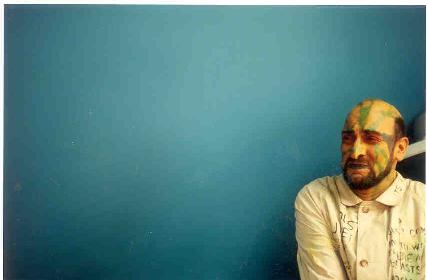
Climb, climb carefully, at the top survey the new surroundings, get bearings.
BLUE.
WARM.
ENCLOSED.
ENCLOSING.
A man looking like a lizard, looking like a plant, looking insane in the centre of the room. And in front, a forest on paper. If we were in a helicopter above the earth, this is what the forest would look like. Or if you were God?
The books are all turned towards the wall. Apart from the occasional one, whose spine reveals a title, all linked to a theme - a meme - spine chilling...?
Take a seat. Against the wall. The Forest, behind me. Behind closed doors. Where Hedvig plays, runs away, escapes, gets shot. (The Forest the unconscious, the Dark Continent, the unknown, the land of Red Riding Hoods, Wolfs and Alien Abductions always the subterranean forest.)
The blue of the room is beginning to suffocate me...
The collage of materials like the mix of the soundtrack lead me down a dizzying array of roads, in which this world becomes more blurred, in which what is real and not real becomes more indistinct, in which stories and facts and givens become tossed up, tossed together, confused, in which links between this attic-forest-world and the world outside here begin to cross one another...
Aliens, fairy tales, ghosts, eco-environmentalism, communism, Nazism, assassinations, crabs turned into frogs, ancestry, Christianity, lizards, spirits, stories, ideologies, beliefs, stories, ideologies, beliefs, explanations, reasons, deludings, ruses, musings, where does it all end? Where does it all begin? With the need to make sense. To find a beginning that leads to an end that we can all swallow. Case solved.
And here, in this hot, dark, blue underworld that is an overworld, it is the very non-sense that makes sense, our drive to sense-making laid bare. The weaving together of various complicated fabrics into fabrications that are intended to hold the truth, but which just offer us various versions. A conspiracy about conspiracies...
I am feeling drugged by it all. I wish, like Hedvig, I could run into the forest.
(email from Dee Heddon to Phil Smith, 16.7.01)
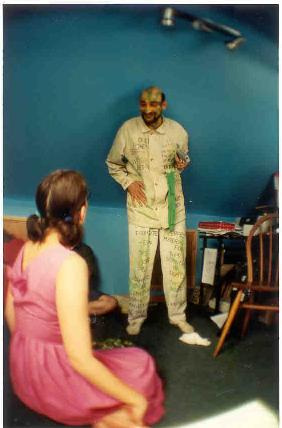
The symbolism of the attic was also evocative - the attic stood as a
domain of fantasy (in very much an Alice kind of way - I loved the use
of the 4 doors in the walls of the attic & read this as referencing
Carroll to some extent) and also as a space of solitude (chiming with
Bachelard's ideas about the attic as shell) - though this was a solitude
which was invaded. Talking of Bachelard reminds me that you were also
engaging with what he calls the 'dialectics of outside & inside' -
played out particularly through the character of the daughter & the
(enchanted?!) broccoli forest
(email from Fiona Wilkie to Phil Smith, 29.6.01)
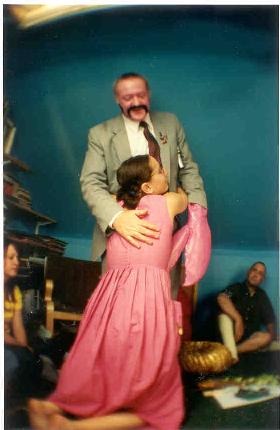
[22] But the process is not ended within a Bachelardian shell:
It's great then that if a tape is given to spectators to take away it might
become a soundtrack to a new site in the future - as you describe with
the Forest Vague Panic tape (which, incidentally, I had a similar
experience of, listening to for the second time as I drove along the
M4 to the Brecon Beacons last week). [24]
SCENE 1: Exeter St. Davids to Glasgow Central.
It's Friday the 13th.
The Soundtrack to "Vague Forest Panic" is playing.
The train approaches Lockerbie.
It doesn't stop this time.
Often it has.
Even when it merely rushes through, though, she always finds herself wondering. [25]
Sometimes when I am adapting classic or modern novels for the stage the act becomes autobiographical. Not that I identify with any of the characters. But with the book. The vehicle - the ornamental language of Melville or Steinbeck or Bely or Swift - then carries me. The adaptation becomes original, but in the sense of returning to its origins in complexes of successful memes. In a loop I am discovering the part of me that was made in the book - like the chemical elements that make up my body (except for the hydrogen) once made in stars.
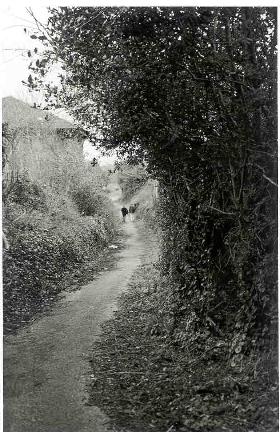
[23] Now I am walking in nature in culture in nature in culture (left foot and then right foot and then...) motion and shape retaining that part of postmodernism which makes nature and culture discursive fields equally irreducible to "fact," but not its favouring of a depthless present as any more than the territory of a supermodernity accessible to a minority, among them the academic disguised as a plane-hopping Businessman-Everyman in Marc Augé's Non Places. [26] I am walking always in the midst of moving vehicles of ideas, but part of that fleet is an evolved, material reality remote from human consciousness and unconscious of it. I may walk among the vehicles, but everything I think is part of their cargo. I am not a solitary moving figure in a still landscape. I am in motion among many wavelike movements in an agitated energy field. All around virtual particles are coming in and going out of existence, borrowing their energy and paying it back - new things happen, but there is no such thing as independence. I am not discreet at any level. Why imagine it is so at the imaginary, why think it at the thoughtful? An unstable subject, among discursive fields of nature and culture held back from becoming 'fact', the modesty of my disreputable companion - memetics - making my autobiography unexceptional, its Fortean enjoyment of the anomalous, the mutant, the mimetic aberration as the motors of cultural evolution, makes it utopian - not a process for resolution into 'fact', but into future, it restores time to cultural theory through the necessity (and inadequacy) of 'imitation' one thing after another not in art but in its vehicles. And as time is space so totality is redeemed... as a concept, now... later, maybe socially...
[24] The sites of this redemption are many. Severs' atmospheres, the "unhomely" walking of the city's uncanny places, alternative histories/speculative worlds, the situationists' ambiences our aesthetic attraction to their vehicles (their beautiful limitations, their sublime expanses, their elegant concepts) is a symptom of their cultural/natural selection. But they are also the physical/non-physical 'places' where intensity is to be had. To give 'it' up to. The 'home' that Severs calls "refuge." Not a "castle." The diaphanous opposite. For ambience the meeting points of differences, wormholes, cultural border posts, eating in the kitchens of foreign cafés - this is a return to the idea of "ether" - that there is some linking matter (or time) through which flow the energies that make 'actions at a distance.' Having junked the "ether" speculative physics in trying to reconcile quantum theory with general relativity is returning to it in the guise of energy fields or tiny loops in space-time. Are the "ambient hubs," that I now go seeking on dérives, fortuitous spaces from which to access the psychogeographic energy field, the memetic equivalent of those emergent, connectionist, spring-like systems - "every virtual point in space... related to every other point... describ(ing) relationships between points in space rather than the points themselves" - using the principle of "tensegrity to produce stable forms?" [27] If I am right, then in those ambient places it is possible to engage with the 'simple' memes before they become, in emergence, a bewildering complexity.
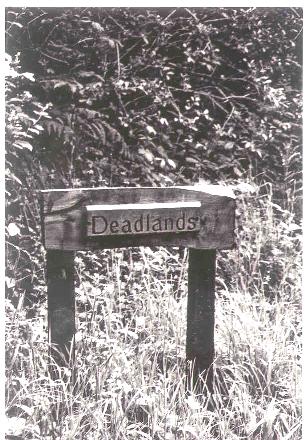
[25] In popular cultural terms it's that moment in the 'invasion movie' (The Thing in horror, Evolution in comedy) when the attributes of an 'infection' and the conditions of its environment are computed and the screen simulation of the Earth rapidly colours red as a day counter slowly ticks over. This exceptional "hub" is where we can discover the common. The local where we can effect "action at a distance," put our gravitational pull on the springs connected to elsewhere.
«http://www.crd.rca.ac.uk/staff/richard»
I began this autobiographical journey in nostalgia. In The Lollipop Guaranteed For A Thousand Licks (1998) and in Bubbleworld (1999) I again wrote what and as I wanted after twenty years as a playwright. I put my want on the space. At first, in a ghost space the room above the exhibition of seaside artefacts and wildlife and then in a space where I was nostalgic every day, my own back garden, "...when you mention the back garden work I see a brick wall and I want to look over it to see the motorbike man." [28] But nostalgia is, when interrogated, no more than utopia in another guise. Nostalgia demands the past be better than it was. At first, in a banal binary manoeuvre, I turned the nostalgia in my art to utopia (and cautionary dystopia in Forest Vague Panic). Then, breaking with the binary, the heightened sentiment of looking back became the intense looking around of dérives; hyper-sensitised, paranoid with possibilities. And in this a-theatrical walking is all the fiction - not of performance, but of the future - that I could wish for. This is why documentation inside the event is so important for me - because the search for ambience is a utopian effort, the search for key points in an energy field, susceptible control parameters, that, when stimulated, will create actions at a distance analogous to the creation of new memes which, if successful, will make new parts of many complex selves. My move from privacy to public again.
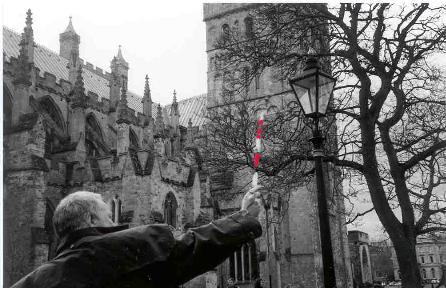
[26] The walking started as a throwing off of the stationary in site specific performance with Exeter-based performance artists Wrights & Sites.
«http://www.ex.ac.uk/~shodge/ws.html»
Dissatisfaction with a defensive reflex: having escaped the conditions of theatre buildings I was caught reproducing them in other sites. Walking away from that. Walking as a dissolving of audience/actor. The walking is always a disruption of other journeys: to work, to shops, to pre-digested entertainment. Cutting through the "undifferentiated city...the magma of inert signs" - in Pierre Mayol's description of "what 'going to work' really means" [29] to a porous specificity of place. Not a ramble. I don't even much like my comfortable rucksack because it makes me look like a rambler. I wear not walking boots but old work boots - from cutting grass on council estates (housing projects) for Bristol's city council. No fixed routes beforehand. Turnings chosen usually on a feel for the ambience. Occasionally the toss of a coin or throwing a pointer-stick.
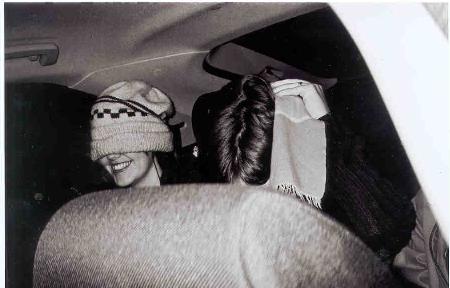
[27] Using catapults - blindfolded in taxis, paying a few notes and leaving it to the driver (Taxi To Westwood and Featureless, 2002) or leaping on and off buses unsure of their destinations (Re:Bus, 2001). Trespass. Visiting private gardens like museum-goers. Parodying archaeology in excavating piles of refuse, building a monument of frames from burned sashes and seared bricks and windows. Ludic. Seriously. Seeking emergence. Phoning and emailing near and distant participants from call boxes along the way of Re:Bus, making inspirational records/temporary models:
Got it -- thanks so much! Only read bits of the booklet, but it's such
a
great idea, just as an object. Makes me want to organize a dérive of
Vancouver, and this is a compliment, I think, in the sense that a motive
of art can be to inspire other forms of art/inquiry. [30]
From Re:Bus construct an unreliable re-walking for guests that becomes
cathedral-Moto-cathedral that becomes Moto Misguide, guests
inviting their own guests...
[28] It is crucial to make the documentation as part of the primary work. There is no absolute virtue in site-specificity. It is not a "thing in itself." Equally, the dynamic patterns of agency and self-organisation are not latently benevolent.
Site-specificity can be, and is, deployed as a means of rejuvenating national and "super-national" ideology at a local, regional or "community" level, reinventing elitism in site-specificity's unique sites and access difficulties, reinvigorating an aristocratic-like site-making in opposition to marketisation; an asceticism that then eats itself as the specific works disappear and then reappear in "a long after-life in artificial memory: in archives and CVs, in photographs, compact disks, catalogues, postcards, posters, in monographs and other art books..." [31]. This can be combated by making the documentation part of the emergent process, not an afterwork, but a simple model of increasingly complex future ones.
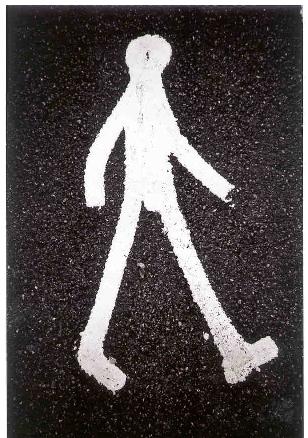
If the "hubs" are the way in to the psychogeographic totality then presence is crucial. 'Placing' oneself. The act of walking become autobiographical not as the placing of a point on a plane, but as the shifting of patterns in relation to others. The walker brings their multiple histories to the 'hub' and the writer places their geometrical selves in the textual 'flow' of the book they are adapting. But the documenting is essential. The dérivistes, like the proletariat, have no monasteries. They may find some margin in the universities. But there is no systematic memory for them. Only by documenting and diffusing their own work - as they make it - by amplifying it through the use of ambience, by constructing and distributing practical tool kits for ludic use on "drifts," by articulating their own principles - so easily transferable, unlike the disciplines of much art and theatre - can they begin to totalise their presences. Neither on a shamanic model, nor by the aesthetics of the revolutionary Symbolists who imagined the act of their own transfiguration would transform their audience in a mystical/material chain reaction. But in the banality of the document. The non-site of documented 'presence' elsewhere. Action at a distance; the emergent invitations to "drift." Map become autobiographical. Archaeology subversive. Guide-book become mis-guide. Tourism become utopian.
Notes
[1] Edwards, R.A. & Scrivener, R.C. "Geology of the Country around Exeter London," The Stationery Office, 2000.
[2] Massey, D. "Contribution to a Symposium on the work of walking artist Hamish Fulton at the Tate Britain Gallery," London, April 2002. From the author's notes.
[3] Smith, P. "Taxi To Westwood and Featureless," unpublished document, 2002.
[4] see Blackmore, S. In Search Of The Light (The Adventures of a Parapsychologist), New York, Prometheus Books, 1996.
[5] Smith. P. ibid.
[6] see pp. 86 7 Conte, R. "Memes Through (Social) Minds" from Aunger, R. Darwinizing Culture: The Status of Memetics as a Science London, OUP, 2000.
[7] see Blackmore, S., "Waking From The Meme Dream," paper presented at The Psychology of Awakening: International Conference on Buddhism, Science and Psychotherapy, Dartington, 7 10. 11. 96 at « http://www.memes.org.uk/meme-lab/DART96.HTM».
[8] p.41 Blackmore, S., From "The Meme's Eye View" from Aunger, R., Darwinizing Culture: The Status of Memetics as a Science London, OUP, 2000.
[9] p.235 Blackmore, S. The Meme Machine, Oxford, Oxford University Press, 1999.
[10] p.140 Kelso, J. A. S., Dynamic Patterns: The Self-Organization Of Brain and Behaviour Cambridge, Mass., MIT Press, 1997.
[11] p. xi Kelso, ibid.
[12] p.11 Kelso, ibid.
[13] p.45 Kelso, ibid.
[14] pp. 189-90 Kelso, ibid.
[15] p. 189 Kelso, ibid.
[16] p. 197 Kelso, ibid.
[17] Smith, P. ibid.
[18] p.133 Kelso, ibid.
[19] p.45 Kelso, ibid.
[20] p.94 Kelso, ibid.
[21] Smith, P. ibid.
[22] p.94 Kelso, ibid.
[23] p.7 Severs, D. 18 Folgate Street London, Chatto & Windus, 2001.
[24] email from Fiona Wilkie to Phil Smith 29.6.01.
[25] email from Dee Heddon to Phil Smith 16.7.01.
[26] pp 1- 3, Augé, M., trans. Howe, J., Non Places: Introduction to an Anthropology of Supermodernity London, Verso, 1995.
[27] pp.33 & 38 Brown, R. Biotica: Art, Emergence and Artificial Life, London, RCA CRD Research Publications, 2001.
[28] Persighetti, S. email to Phil Smith, 12.4.02.
[29] de Certeau, M., Giard, L., Mayol, P. The Practice Of Everyday Life, Volume 2, (trans. Tomasik, T.) Minneapolis, University of Minnesota Press, 1998.
[30] Lovejoy, B. email to Phil Smith, 2.4.02.
[31] p. 25 Stallabrass J., Broekman P.van M., Ratnam, N. Locus Solus: Site, Identity, Technology in Contemporary Art, London, Black Dog, 2000.
Bibliography
Althusser, L. Lenin and Philosophy and Other Essays, London, NLB, 1971 Augé, M., trans. Howe, J., Non Places: introduction to an anthropology of supermodernity London, Verso, 1995.
Aunger, R. (ed.) Darwinizing Culture: the status of memetics as a science London, OUP, 2000.
Bachelard, G. The Poetics of Space, Boston, Beacon Press, 1958.
Blackmore, S. The Meme Machine, Oxford, Oxford University Press, 1999.
Brown, R. Biotica: Art, Emergence and Artificial Life, RCA CRD Research Publications, London, 2001.
Chown, M. The Universe Next Door, London, Headline, 2001.
Danielewski, M.Z. House Of Leaves, London, Transworld, 2000.
Dawkins R. The Selfish Gene, Oxford, Oxford University Press, 1976.
Eagleton, T. Criticism and Ideology, London, NLB, 1976.
Edwards, R.A. & Scrivener, R.C. Geology of the Country around Exeter, London, The Stationery Office, 2000
Kelso, J. A. S. Dynamic Patterns: The Self-Organization Of Brain and Behaviour Cambridge, Mass., MIT Press, 1997.
Leppin, P. Severin's Journey Into The Dark, Mόnchen, Delphin Verlag, 1914, (trans. Blahut K., Prague, Twisted Spoon Press, 2001).
Meyerink, G. The Golem,
Mithen S. The Prehistory Of The Mind, London, Thames & Hudson, 1996.
Rosen, M. On Voluntary Servitude: False Consciousness and The Theory of Ideology, Cambridge, Polity, 1996.
Severs, D. 18 Folgate Street, London, Chatto & Windus, 2001.
Stallabrass J., Broekman P.van M., Ratnam, N. Locus Solus: Site, Identity, Technology in Contemporary Art, London, Black Dog, 2000.





